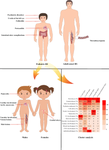World Journal of Pediatrics ( IF 8.7 ) Pub Date : 2024-02-05 , DOI: 10.1007/s12519-023-00785-9 Dan Hu , Chun-Hui She , Hua-Fang Bao , Jun Zou , Jian-Fei Cai , Jing‑Fen Ye , Yan Shen , Hai‑Fen Ma , Dan Luo , Jian-Long Guan

|
Objectives
Behçet’s syndrome (BS) is a rare disease of unknown etiology, with limited reports especially in pediatric BS. The clinical characteristics and phenotypes of pediatric BS as a highly heterogeneous variable vessel vasculitis were investigated in this study.
Methods
A cross-sectional study was conducted to compare clinical variables and descriptive characteristics of BS by age of onset and gender. Cluster analysis was then performed to identify the phenotypes of pediatric BS.
Results
A total of 2082 BS patients were included in this study, 1834 adults and 248 children. Compared with adult-onset BS, pediatric BS had a higher incidence of folliculitis [relative risks (RR) and 95% confidence interval (CI) 1.3 (1.0–1.5)], uveitis of the left eye [RR and 95% CI 2.3 (1.0–5.0)], intestinal ulcer complications [RR and 95% CI 2.1 (1.1–4.2)], pericarditis [RR and 95% CI 2.5 (1.0–6.2)], and psychiatric disorders [RR and 95% CI 2.8(1.0–7.9)], while the incidence of thrombocytopenia was lower [RR 0.2 (0.1–1.0)]. Among pediatric BS, females had more genital ulcers, while males were more likely to have skin lesions, panuveitis, vascular involvement, venous lesions, cardiac involvement, and aortic aneurysms. Cluster analysis classified pediatric BS into five clusters (C1–C5): C1 (n = 61, 24.6%) showed gastrointestinal (GI) involvement; C2 (n = 44, 17.7%) was the central nervous system (CNS) type where 23 cases overlapped joint involvement; in C3 (n = 35, 14.1%), all patients presented with arthritis or arthralgia; all patients in C4 (n = 29, 11.7%) manifested ocular involvement, with a few patients overlapping with GI involvement or joint damage; C5 (n = 79, 31.9%) was the mucocutaneous type, presenting both oral ulcers, genital ulcers, and skin lesions.
Conclusions
The clinical features of pediatric and adult BS differ significantly. Male and female pediatric BS also have a distinct demography. Five phenotypes including GI, CNS, joint, ocular, and mucocutaneous types were identified for pediatric BS.
Graphical Abstract
中文翻译:

儿童白塞氏综合征的临床异质性和五种表型:来自上海白塞氏综合征数据库的队列研究
目标
白塞氏综合征 (BS) 是一种病因不明的罕见疾病,尤其是儿科 BS 的报道有限。本研究调查了小儿 BS 作为一种高度异质性可变血管炎的临床特征和表型。
方法
进行了一项横断面研究,以按发病年龄和性别比较 BS 的临床变量和描述特征。然后进行聚类分析以确定儿科 BS 的表型。
结果
本研究共纳入 2082 名 BS 患者,其中 1834 名成人和 248 名儿童。与成人发病的 BS 相比,儿童 BS 的毛囊炎 [相对风险 (RR) 和 95% 置信区间 (CI) 1.3 (1.0–1.5)]、左眼葡萄膜炎 [RR 和 95% CI 2.3 ( 1.0–5.0)]、肠道溃疡并发症 [RR 和 95% CI 2.1 (1.1–4.2)]、心包炎 [RR 和 95% CI 2.5 (1.0–6.2)] 以及精神疾病 [RR 和 95% CI 2.8(1.0)] –7.9)],而血小板减少症的发生率较低[RR 0.2 (0.1–1.0)]。在儿科BS中,女性更容易出现生殖器溃疡,而男性更容易出现皮肤病变、全葡萄膜炎、血管受累、静脉病变、心脏受累和主动脉瘤。聚类分析将儿科 BS 分为五类 (C1–C5): C1 ( n = 61, 24.6%) 表现为胃肠道 (GI) 受累; C2(n =44,17.7%)为中枢神经系统(CNS)型,其中23例重叠关节受累;在 C3(n = 35,14.1%)中,所有患者均出现关节炎或关节痛;所有 C4 患者(n = 29,11.7%)均表现为眼部受累,少数患者同时伴有胃肠道受累或关节损伤; C5(n = 79,31.9%)为皮肤粘膜型,同时出现口腔溃疡、生殖器溃疡和皮肤病变。
结论
儿童和成人 BS 的临床特征存在显着差异。男性和女性儿科BS也有不同的人口统计学特征。儿科 BS 被确定为五种表型,包括胃肠道、中枢神经系统、关节、眼部和皮肤粘膜类型。






























 京公网安备 11010802027423号
京公网安备 11010802027423号